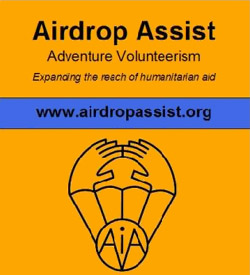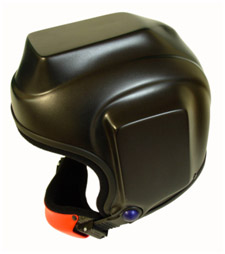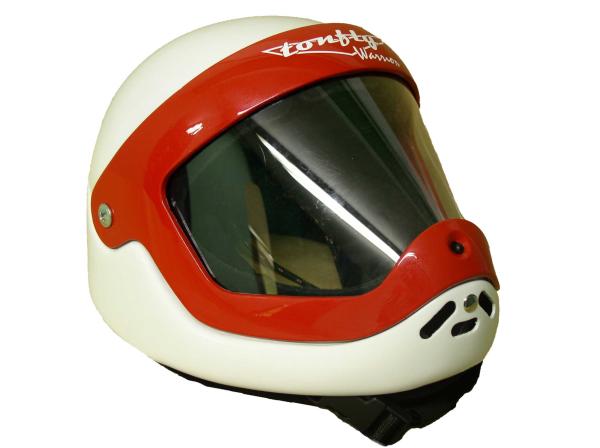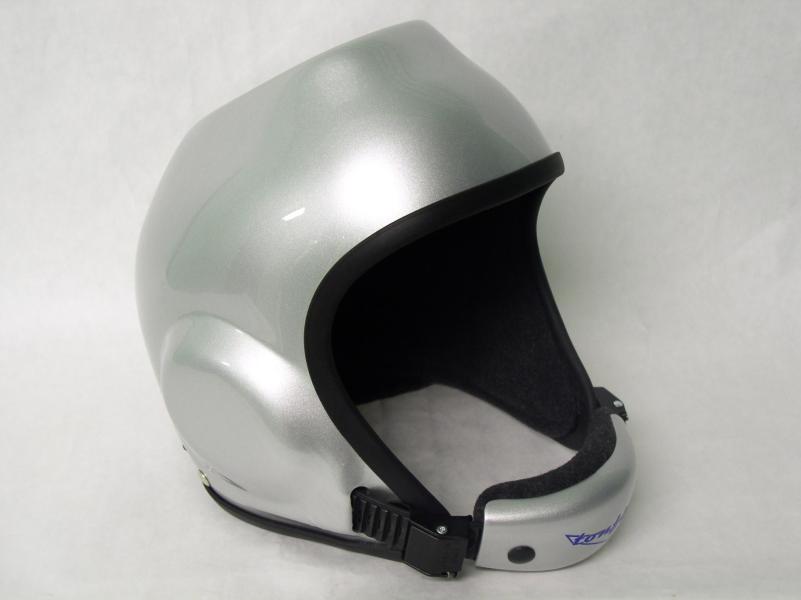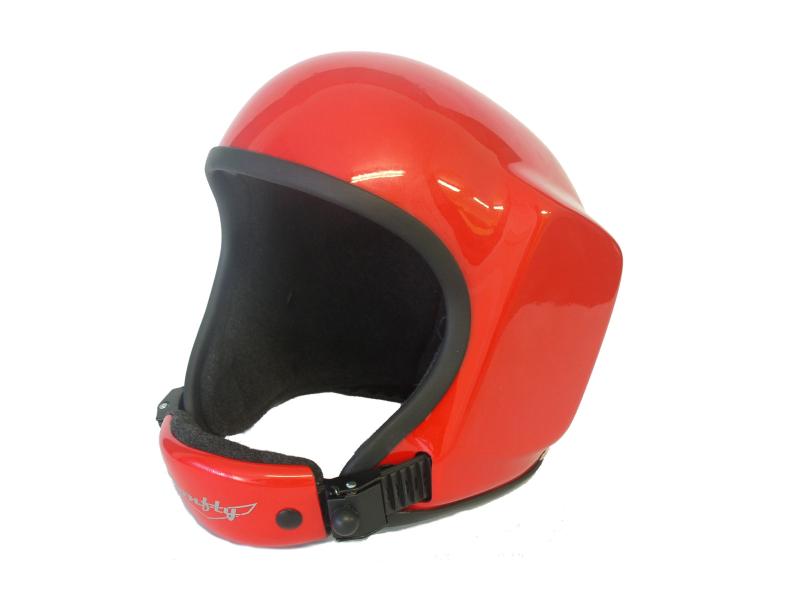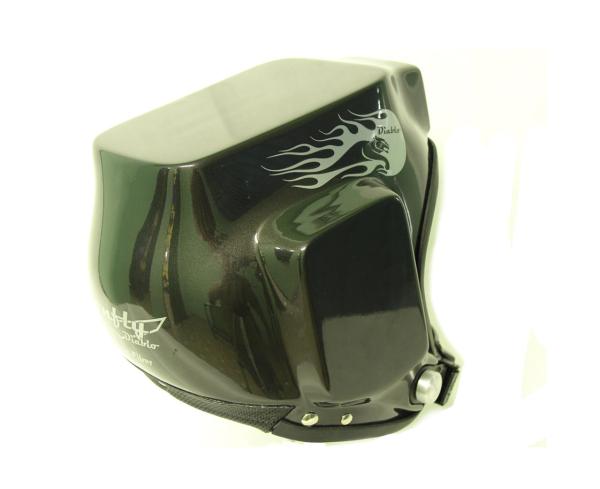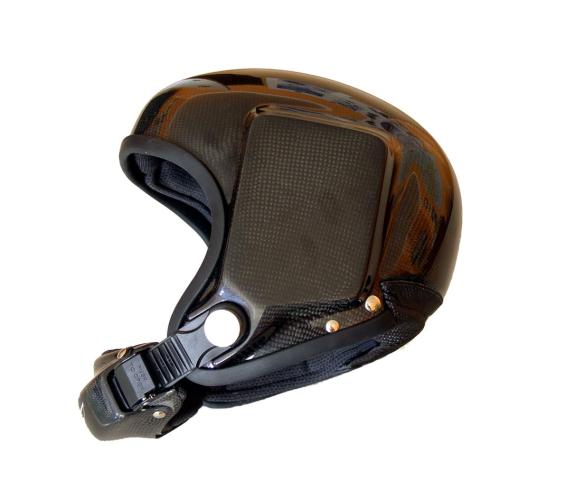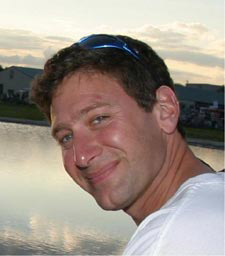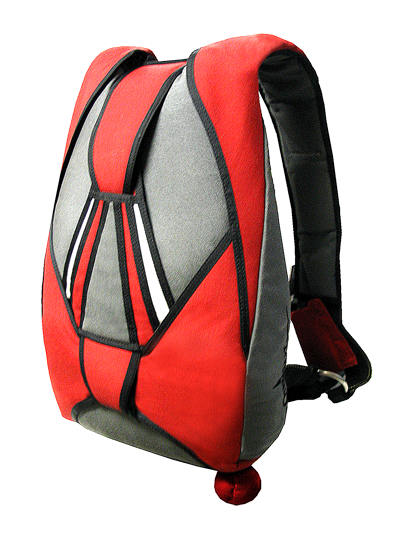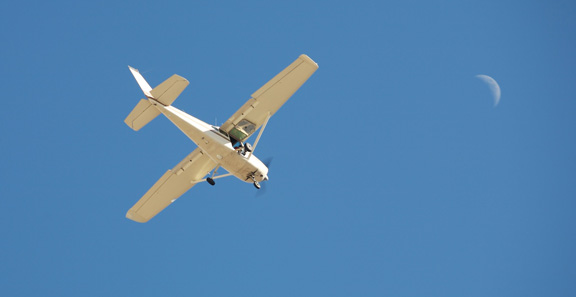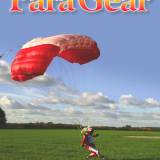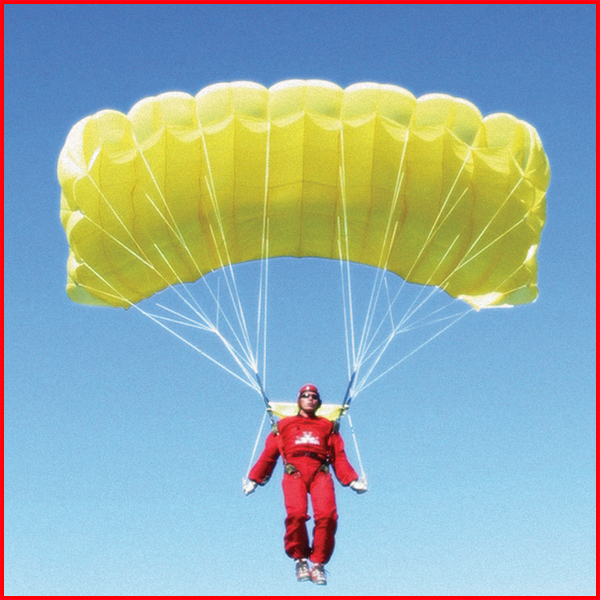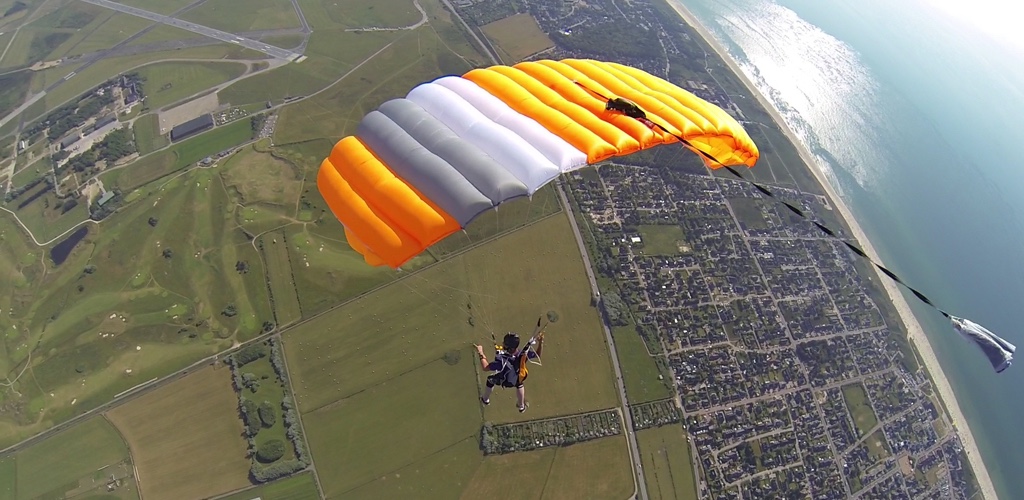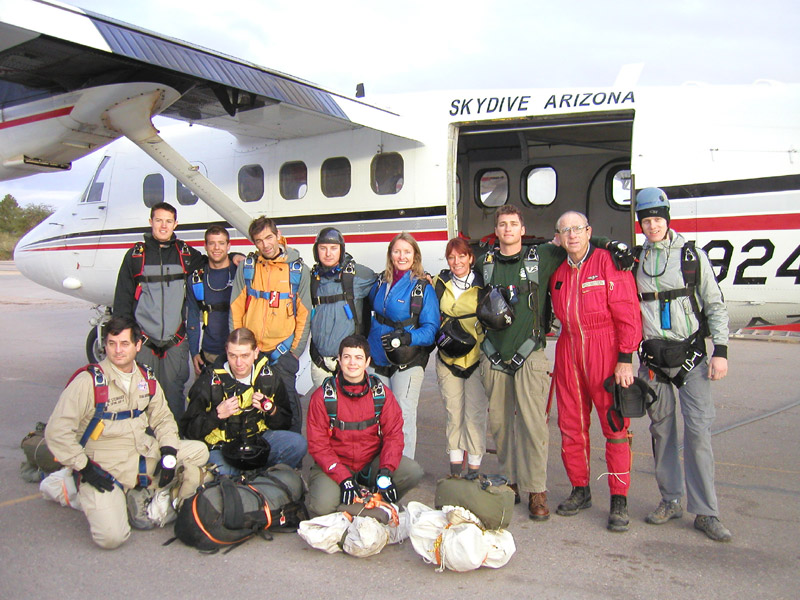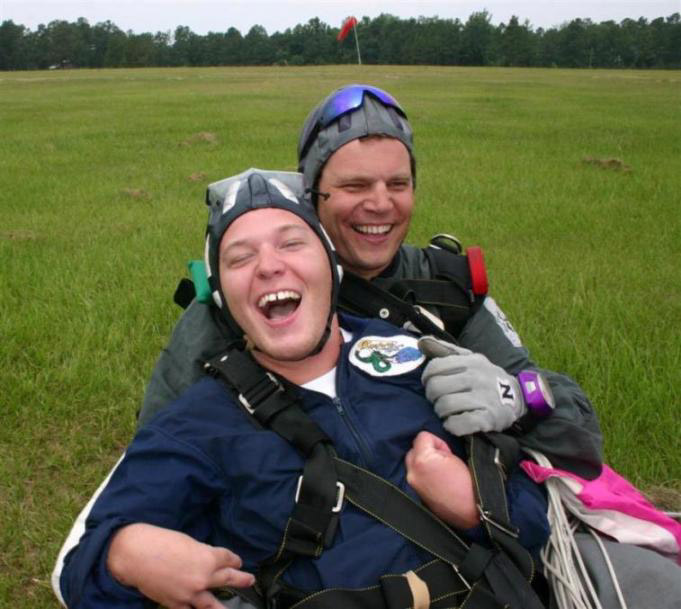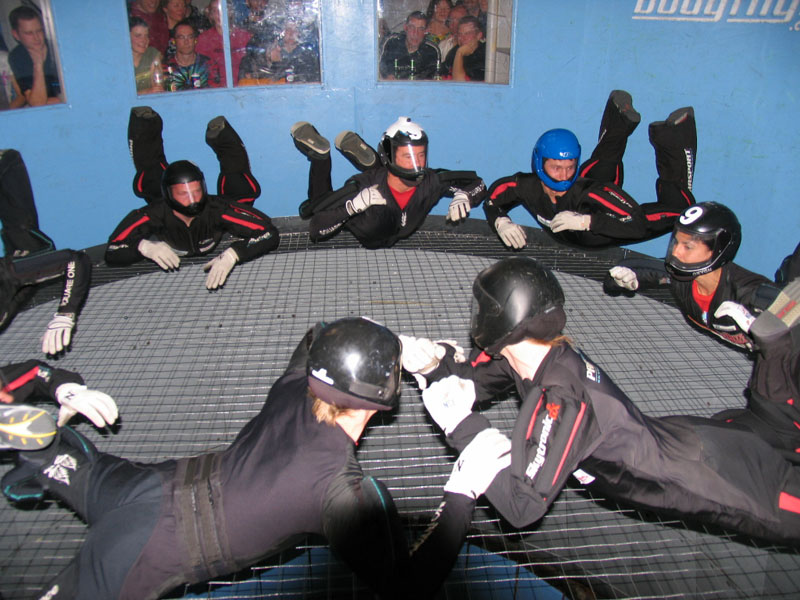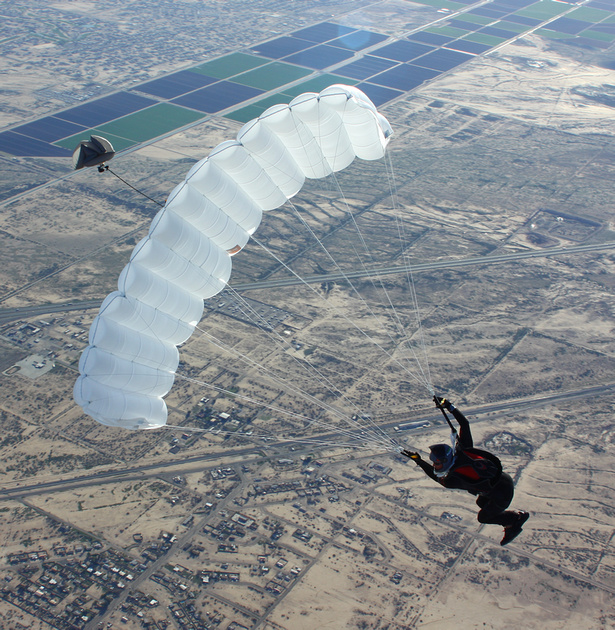-
Content
-14 -
Joined
-
Last visited
-
Days Won
1 -
Feedback
0%
Content Type
Profiles
Forums
Calendar
Dropzones
Gear
Articles
Fatalities
Stolen
Indoor
Help
Downloads
Gallery
Blogs
Store
Videos
Classifieds
Everything posted by admin
-
One of the most dreaded conditions of all is the no wind scenario. This fear is so profound that many jumpers in fact avoid jumping in no wind conditions. Although landing with the benefit of a headwind is unarguably easier, there are specific methods that markedly improve the chances of standing up your landing. Here are a few tips that will help you to land softer and safer when the wind goes away: 1) Make sure you level off within touching distance from the ground. If you finish the flight with some space between you and the earth, you will have more than just forward speed to deal with at the end of the landing. All parachutes stall above zero airspeed, which means that as soon as the extreme slow flight capability of your parachute is attained, it will drop you into the ground with both forward and vertical movement. The best way to deal with this is to be sure that you have already arrived at standing height when the stall breaks. That way, the only remaining kinetic energy is forward movement, which can be diminished by taking a few controlled steps. 2) Make sure your brakes are short enough. Most manufacturers set the brake lines to allow for a certain amount of slack so that when the front risers are applied with the toggles in the hands, there is no tail input. This, coupled with shorter risers (most parachutes are set up for 21 inch risers), will prevent you from reaching your parachute's slowest flying speed. With the help of your rigger, shortening the brake lines is an easy task. Take out not more than one inch at a time and give it a few jumps before taking more out. 3) Keep the parachute over your head. Any tilt in the roll axis will result in a premature stall of the parachute, which will drop you into the ground while you still have ground speed. This is due to an effect known as "load factor". When a wing is in a bank, it requires a bit of increased angle of attack to keep it flying at the same height or descent rate. This results in an increased relative weight, which in turn increases the stall speed. Keep your eyes looking down the "runway" and you will be able to notice variance in your bank angle easier. Making smooth corrections to the bank angle all the way to the end of the landing will result in a softer touch-down and less forward velocity at the end of the ride. 4) Be sure that you are finishing the flare. Keep smoothly adding brakes until you run out of arms, or ground-speed, whichever comes first. In other words, if you are flying into a significant head-wind, flaring all the way down will make you go backwards, as the speed of your parachute will be less than the speed of the wind. Flaring straight down is the only way to accomplish a complete flare, as stylish outward sweeping of the arms out to the sides or to the back will only result in a stylishly ineffective flare. The brake lines can only work if they are pulled. 5) Assuming that a PLF is not necessary, put one foot under your spine, as the "main landing gear", and the other out in front as the "nose gear". That way you will not plant both feet at the same time and pivot onto your face. Slide your main gear along the ground as long as you can, and then when the friction finally grabs your foot, take that first step onto the front foot. 6) Loosen your chest strap and lean forward in the harness. This will allow you to get your weight over your "landing gear", rather than back on your heels. The parachute will increase its pitch angle as you progress through the landing, but your body doesn't have to tilt in accordance. Freeing your body from the pitch of the system will allow you to feel more comfortable finishing the flare, as you will not feel the urge to let up on the toggles as you put your feet down to get to a more balanced pitch angle. 7) Let the wing sink down below standing height during the second half of the swoop, and then use the canopy's lift to bring you back up to standing height. Referred to as the "Seagull Landing", this allows you to arrest any excess forward speed, as you will be in a climb at the last part of the landing. Be sure not to climb above standing height as you do this, as that will result in a drop at the end that will put you on your face. 8) Practice slow flight up high. The more comfortable you are with the low-end range of your canopy's performance envelope, the longer you will be willing too keep your toggles down at the end. Fear of the stall results in incomplete flares, as well as letting up the toggles at the end of the landing. Keep the canopy in brakes for at least 30 seconds (up high), and perform smooth turns right and left. This will help you fly your way out of any bank angle created by an asymmetrical level off during the flare. 9) Believe it is possible to land perfectly. It is. Only when a pilot thinks: "I am going to crash" is the crash inevitable. 10) Get video! There is no greater tool than actually seeing yourself land. The best way to get filmed, I have found, is to film other people. Landing in no wind can be great fun. Ultimately, this is how we counter the fear of landing our parachutes. If you lean forward into the experience, your positive body language results in more fluid, appropriate actions that actually improve your situation. When you are comfortable with landing in no winds, you begin to actually look forward to those zero-wind sunset loads. Scooting across the ground with maximum forward speed can be incredibly enjoyable when you know you have the skills to handle the situation. In the end, the only way to achieve this is to jump on a regular basis, and enjoying the learning process is how this is reinforced. Find something about every landing that you can smile about, even your crashes. Everything that is not the path shows us where the path is not. Happy Landings! Bryan Germain www.CanopyFlightInstructor.com Editors Note: Also see - Another Look at No-Wind Landings by Scott Miller
-
FTC toll free hotline: 877-FTC-HELP (877-382-4357) FTC online complaint form (www.ftc.gov) Canadian PhoneBusters hotline: 888-495-8501 Internet Fraud Complaint Center (www.ic3.gov) Non-emergency number for your local police department. If you suspect that an item posted on Dropzone.com or a inquiry from a buyer is a scam: Visit the Security and Scam Alerts Forum to see if it has been reported. Email the details to "abuse@dropzone.com". Be sure to include the URL or ad ID (on the bottom right corner of the posted ad) in your message.
-
Back in 1936, snow skiing was a sport that only a few dedicated individuals pursued. The primitive conditions practically guaranteed that anyone foolish enough to ski would eventually be injured. On the snowy slopes of a Vermont mountain, just that happened to Charles Minot "Minnie" Dole when his ankle snapped in a fall. His friends went for help, but eventually had to toboggan him off the slope themselves, using a piece of sheet metal roofing material as an improvised rescue sled. The ankle fracture was so bad that Dole was told he would probably never ski again. A few months later, one of Dole's friends who had helped him down the mountain was killed in a ski racing accident. Dole was not only determined to recover and ski again; he was also determined to do something about making skiing safer. He co-founded the National Ski Patrol in 1938, modeling it after some of the informal ski patrols at local ski areas and grafting on some of techniques used by Swiss ski instructors and mountain guides. After World War II, skiing boomed in popularity, equipment and services improved, and the National Ski Patrol is now the largest winter safety organization in the world. To this day the NSP serves an invaluable function in preventing or responding to skiing accidents with special training and equipment. Skiing and skydiving have many parallels. They evolved over roughly the same time frame, and advanced rapidly after World War II. During the sixties and seventies national organizations formed, services improved, training became professionalized, and equipment evolved rapidly. Similar sports enjoyed similar progress. Swimmers and surfers have trained, well equipped lifeguards. Climbers have mountain rescue specialists and spelunkers have cave rescue organizations. But for some reason skydiving has never evolved an organization dedicated to preventing accidents, responding to them where and when they happen, and evaluating them to learn how to make the sport safer. Considering the frequency of skydiving injuries, there is an obvious need for trained response. All outdoor sports share some commonalities. Each takes place in an unusual environment, with specific environmental hazards. Each has specialized equipment and skill sets. Each has an undeniable element of risk, yet those risks are not mysterious and can be mitigated through proper preparation. Skydiving can learn from other forms of outdoor recreation and develop a national training program to prepare drop zone staff and volunteers in accident prevention, preparation, and response. Such an organization, modeled after the National Ski Patrol, may be just around the corner. This December Skydive Arizona will host a training course that will also serve as an opportunity to examine what is needed to bring this sort of organization to your drop zone. At the core of the program will be a Wilderness First Responder course from a nationally accredited organization. The WFR was chosen over standard EMT training because of a heavier emphasis on trauma, and on managing it without access to immediate ambulance response, since many DZs are a long ways from the nearest ambulance. In addition to the WFR, the course will include modules on skydiving specific problems such as aircraft and fuel safety, removing skydiving equipment from injured jumpers, recovering cut-away equipment, problems involving tree, water, and power line landings, and incident investigation. Relationships with the local emergency medical system and with the FAA will be reviewed. Recognizing and mitigating hazards will also be discussed, as will incident reporting and the possibilities offered by building up a national database of accidents. The course, scheduled for December 1 - 10, 2007 is open to any interested skydivers, regardless of their experience in the sport. Slots are limited and must be reserved well in advance. The course cost is $600, which includes instruction, materials, and training aids. Graduates will receive WFR certification from the Wilderness Medicine Institute of the National Outdoor Leadership School. For registration details, go to www.airdropassist.org/wfr.htm The course cost does not include lodging or food. Participants will be engaged in classroom activities all ten days, and actual skydiving is not on the agenda. If you bring your rig, plan on jumping before or after the course. Camping is free. Inexpensive team rooms or bunks are available on the drop zone. There are several hotels nearby. For lodging and travel information, go to www.skydiveaz.com. For other questions, contact Bryan Burke at: bryantburke@hotmail.com.
-
According to his bio on the Avalore team page (www.avalorefreefly.com), Adam Mattacola, apparently began jumping in 2004 at my local drop zone, Sibson, near Peterborough in the UK when he was still in his teens. I don't remember him. Back then I had 200 jumps and thought I was the right royal shiznit. Who was I to look for the new AFF grads to jump with? Pshhh puh- LEASE! I was too busy making sweet 2 way head up jumps and trying my best to look like I knew what I was doing by colour coordinating my free fly suit colours I had on order. I had just got my C and was strapping a camera to my helmet. I was WAY too busy to deal with the likes of this young scrote! Fast forward a few years and an almost quick blink of the eyes later, and the same guy is hot off the presses, having just rolled off the newly awarded Euro 40 way HD record and the 11 way Brit HD record days before his 22nd birthday and he has also been garnered the austere title of UK Senior FF champs 2005 with his Avalore team mates. So is a record holder AND champion. All in the space of a few years since he first started. Accomplished at the sprightly age of 21, a full decade younger than me. "Hmmmmm", I pondered to myself this week, "how in the sweet name of Buddha, Allah, God, Jah and Jehovah did this guy get SO good SO quickly?!" Am I bitter? Of course not! That would be infantile. It's all love in this sport (especially when I might run into the young hotshot at some point and want some coaching off him!). Seriously though, Adam is obviously one of what I like to call the "new breed", one of the "rising stars" and all that other names that people call those very talented, young people who seem to progress so quickly in their given sporting discipline. I was curious to find out how he had managed to do it, in such a short space of time, and share his insights with the members of the skydiving community, old and young alike, so that we could possibly learn something from him, and shine some light on an obviously very talented flyer. So without further ado, I decided to find out just what the hell this guy had been up to to progress so quickly and do so well for himself in such a short space of time. Enjoy! Name: Adam Mattacola AKA Killa Cola Age: 23 Occupation: Airkix wind tunnel instructor/ Coach; AFF Instructor and Skydiving coach First skydive (date and location): Tandem skydive Sibson August 2004, AFF Seville August 2004 Years in sport: 3 Number of jumps: 517 Number of mals: 0 :-) Kit: Vortex2 Hurricane 120, PD120 with CYPRES Describe yourself in one sentence: determined, loves a challenge, loves to get laid and a little crazy. Background:I did a tandem jump in August 2004 at Sibson, I had always wanted to jump out of a plane since I was little....I've always been a little thrill seeker and who loves to do something new...in my head not many people have done skydiving and it scared the majority. I like to be different. After we'd jumped that was it, I was hooked - no fear in me at all and I had a big cheesy smile on my face which I could not wipe off for days. As soon as I landed I went to the internet and booked the AFF!!!! I knew this sport was for me. AFF in Seville 2 weeks later out of a small Cessna with instructors Alex and Jonno (thanks guys). Levels 1-5 I passed first time without a correction signal and with instructors letting go (no tunnel time at this stage). So that night I suppose you can say I got a bit ahead of myself and thought this was an easy ride and went and had a few beers. But stayed out late and only had a few hours kip like you do and went to the DZ knackered. Level 6.....spin flip twist spin spin flip twist all the way down. Hmmm shock to the system. Maybe this is not such an easy ride after all. Repeat Level 6 and yes it was a repeat - literally! ....spin flip twist spin spin spin. Instructor said go home have some rest and lets finish the course tomorrow. Went home had a kip then practiced on my bed all night. I soooo wanted this license. Then the next day I passed all levels and was one happy bunny. Jumped at Hinton. Got into freefly at around 50 - 60 jumps because it was something new and everyone said how hard it was.... I love a challenge, I love to learn something new and hard! I then went to Sibson and started to jump then had a Russia trip to Kolomna, it was great. 84 jumps in 2 weeks. Halfway into Russia I was still rusty in my sit and it took me along time to get to the base. As soon as I got there it was time for break off! Damn! Everyone started to mock me and I was like, "Come on... I only have 70 jumps!" So I decided "I WILL GET THERE BEFORE BREAK OFF!". So, out of the plane and zoom - but I didn't take into account stopping. Straight through the base. "Oops!". My nickname is "Cola" due to my last name and then they just added "Killa" as I tried to kill them all... hence "Killa Cola". A lot of the jumps were 2 way sit with Dylan and now I can freefly. (it's better to learn in smaller groups I think). After 200 jumps my buddy "Big Al" AKA Heman recommended me to Airkix to be an instructor. Thanks to him I got the job. I was an electrician before and was happy to leave. Weeks went on and everyone raved about how fast I picked up flying. I just thought they were being nice. A couple of months in and I was there flying around with the top flyers and then all of a sudden they were asking me how to do things. It was one big hit the first time it happened. The legends asking advice from me, all in just a few months! I competed in the World Challenge 2007 wind tunnel comp with Michi from Bedford. We came fourth, only 2 points behind Babylon, who were third. Avalore at this point, were looking for a third member as one had left. They asked me whilst at Airkix. I wanted to compete and get experience but had no money. Avalore has good sponsorship and let me trial for them at Lillo in Spain and they were happy with me. I am now a member of Avalore by spending next to no money - I'm very lucky. I then wanted to be able to teach anyone, so I did my AFF instructor course at Lillo so now I can teach from complete beginner to advanced headdown and can now pass on my knowledge. I heard about the Euro record and was desperate to take part. It represented something new and challenging and something not many people can say they have done. The biggest I did before that was 7 way head down. I went from the trial straight into a 20 way. Wow! I was buzzing. Got onto the 30 way record attempt out of 70ish people who turned up for the trials. Deep inside I was exploding with excitement but trying to stay cool about the whole thing. We completed it first time. Then it went to 36 people, then up to 40. Then as a fun jump/British record jump we did an 11way - 3 points. Now, when I get the chance, I will train with Avalore for the Nationals and hopefully we will do well. Alot of other good teams are out there. I now do coaching for all levels of skydiving too. A lot has happened to me in a short space of time - sometimes even now I have to step back and take a deep breath and make sure I'm not dreaming as all of this has happened in the space of working at Airkix within 1 year! What's a typical day like for you:Wake up to a cheesy tune as an alarm on my phone, so I can't help but smile even though I'm tired. Hot shower then turn it cold for a few seconds just before I get out. Wakes you up. Go to Airkix to work, give experience and enjoyment and share the sport I love with hundreds of people, and see them smile from ear to ear. Chill out when I get home, then do 'the thing I'm learning' at that particular time. I always like to be learning a new skill from learning a different language to playing piano or guitar or another sport. Then either go to bed or maybe go on my laptop and look at certain pages on the internet which I can't say about in this interview and...well...you know the rest! Who do you look up to in the skydiving world and why:I look up to every high achieving competitor as it takes a lot of commitment, hard work and motivation to be in a team. I also respect a lot of students due to there determination by not quitting when they come to a move they struggle to do. Best jump you have ever had and why:I think maybe the pants jump I did in Russia. Seven of us in just our boxers and all not really very experienced. It was basically naked bodies flying all over the place out of control with the great expressions on their faces - so much fun but we froze our bollocks off! Favourite type of jump right now and why:Has to be a chasing dive with buddies, without trying to lose one another. It's true free flying as you fly at all angles and positions like eagles, carving tracking and belly/ back flying (which I feel are also important areas to be good at) and quick directional changes. Tracking also has to be one of my favourites as I can't do it in the tunnel, and there is so much to do in tracking, so many angles and different speeds. How have you managed to progress so quickly in such a short space of time?Tunnel time for sure is the quickest way to learn skydiving skills. It disciplines you to do everything on spot with a coach right in front of you and if you hit that wall, you don't want do it again so you make yourself do it right! I always pushed myself and never let something beat me because it was too hard to do. I believed in myself and after I flew I watched back over my flights and made sure I understood how the wind works with your body instead of just flying and being able to do it without actually understanding WHY. That's the way to do it, making sure you understand why things happen. Being relaxed is a also a big part of flying, so if possible you need to be sure you're not sexually frustrated. Trust me it affects your flying! Favourite coach you have had coaching from and why?The Airkix tunnel instructors.... a friendly, helpful bunch who have time for their students and they are very good at what they do. What makes a skydiver experienced?Attitude to the sport, safety wise, is very important and that's for both while under canopy as well as in freefall. Also, not knowing HOW to do something but more importantly, WHY it happens - that's the way to learn. If you understand "the why", it is better then doing it a million times and not understanding it. Some people with a couple of hundred jumps have better knowledge of the sport than some guys with a 1000 jumps. What would you change in the sport if you could change any one thing?Make it cheaper and be able to jump from a higher altitude. Where do you see yourself in 10 years?I really don't know...I can see myself still in this sport for sure, but I think mainly just coaching and passing on knowledge I have gathered over the years. I tend not to plan the future - I'm more of a guy who goes with the flow and whatever is around the corner, I've just got to make the most of it. You only live once!!! Greatest non skydiving accomplishment:4th in the Bedford World Challenge, but if you count that as skydiving related then most probably being in a dance video doing breakdancing. Favourite quote:Make it happen and live your dream - life is only as good as you make it. Freefall or canopy ride?Freefall - you share the experience with alot more people while it's happening. Swoop, or straight in?Swoop - it's challenging and it's something new to learn, but it's also very dangerous if you underestimate it. Jump numbers or experience?Experience - if you have the knowledge and understand it, its better than a bit of paper saying I've done 2000 jumps. RSL or no RSL?No RSL - could be a situation where it would not be best if reserve come out straight away. AAD or no AAD?AAD for sure just make sure it's the right one for what you are doing....if you swoop - make sure you have a swoop CYPRES. Fun jump or training:Fun jump - no pressure and makes it easier to enjoy every moment of the skydive Noddy or Big Ears:Noddy Steak or Tofu:Steak... rare The journey or the destination:The journey - the destination may not turn out to be as good as you thought, but getting there is one big adventure and you have no idea how its going to work out. Sex or jumping:Got to be sex, as it is free......well for most people anyway...sex while jumping would be interesting! Money or fame:Money. Fame could lead to no privacy. Money will take a lot of worries away. Many thanks to Adam for taking the time out to answer these interview questions!
-
- Helmet in carbon fibre technology - One piece chincup with tunnel for the ratchet straps - Two flat reinforced sections left side and top - Double audibles room on the right side section - Integral lockage - Extraordinary fit on head thanks to the new inside liners - weight : 635 gr. - available sizes : XS(52-53) - S(54-55) - M(56-57) - L(58-59) - XL (60-61) - XXL (62-63)
-
This helmet with a TM Zkulls system on the top platform and with a the left flat side section allows you to connect and disconnect your videocamera box or your still camera base plate on top and to have a additional videocamera box fix mounted in the left side. - Helmet in carbon fibre technology - One piece chincup with tunnel for the ratchet straps - Two flat reinforced sections left side and top - One TM ZKULLS connection system fitted on the TOP mount - Double audibles room on the right side section - Integral lockage - Extraordinary fit on head thanks to the new inside liners - weight : 705 gr. - available sizes : XS(52-53) - S(54-55) - M(56-57) - L(58-59) - XL (60-61) - XXL (62-63)
-
-
-
-
-
-
14R1400. Sound like something out of a Swartzenegger movie? Its not exactly extraterrestrial, but as Simulators go, this one comes pretty close. Montreal businessman and investor, Alain Guerin, has embarked on a groundbreaking wind tunnel simulation project in Canada, involving a 1400-horsepower, energy efficient recirculing tunnel. 14R1400 is 14 ft in diameter, the first cylindrical flight chamber with four 350-horsepower fans. The foundation for Skyventures' $6 million green wind tunnel, a below-ground 100 ft long plenum installation is to begin in September, followed by erecting the 70ft tall frame. The project is set for an April 2008 completion date. 56-year-old investor, Alain Guerin owns several businesses as well as an accounting firm and lectured as a professor at the University of Quebec. Unlike most Chartered Accountants, Alain has a penchant for adrenalin-based sports. In the infancy of his skydiving career he found hitches getting through his certification which lead to revolutionary ideas. Alain says: "I needed a way to hone my skills in a safe, stress-free environment and every answer I found pointed to Skyventure." The design is like 'freefall virtual reality', offering skills honing for skydivers on all levels of experience. Unlike previous designs, the wall-to-wall airflow reduces the danger of falling off the column of air. Alain and his partner, Pierre Beaudoin have selected three locations in the greater Montreal are which will eventually be narrowed down. Skyventure Montreal will be constructed near a fully equipped shopping mall complex with movie theatres, restaurants etc. "Our mission is to provide the Quebec market with the most advanced, efficient, safe, reliable, powerful and realistic skydiving simulator in the world. More specifically, to become the most sought after, fun, exhilarating experience for the local population, the tourism industry, corporate groups and skydiving enthusiasts." adds Guerin.
-
A large sector of the skydiving population is currently in danger of extinction. This is because of the widespread proliferation of new DZ rules that prohibit 270 turns for landing or ban high speed approaches entirely. Consequently, many jumpers now find themselves homeless and considering alternate sports - not a good thing for skydiving. These new restrictions come in the name of safety. We have lost many friends this year due to canopy collisions, and the management at several dropzones has responded by adding new rules in an effort to prevent such accidents from happening in the future. There are several aspects within this direction of policy that concern me. Remember 9-11? We felt unsafe after the tragedy, and so we willingly gave up many of our rights as free citizens. Now they are taking nail-clippers away from little old ladies. It is getting ridiculous, as is the policy banning advanced approaches. It is a knee-jerk reaction to fear, and I think we all know where that slippery slope leads. "My rights end where your rights begin."This is the fundamental idea that forms civilization. In other words, if I fly my parachute into you in the pattern, I am in the wrong. I think everyone agrees with this and it therefore can and should be asserted that if my behavior does not have an effect on anyone else, I should be allowed to continue to do what I am doing, provided I am doing it in a safe manner. We all need to challenge ourselves. This is what keeps us showing up at the dropzone every weekend. Thousands of people enjoy the challenge of high speed approaches and define the swoop landing as an essential part of their experience. They wait all week to get a few jumps in over the weekend, and now many of them are unable to get what they came for. To take that away is to cut many people off from the very reason why they skydive in the first place. Is that really where we want to go with this? We cannot afford to alienate anyone. There are precious few experienced skydivers in the world and I would argue that we are the reason for the dropzone in the first place. I understand that there are a few DZOs that are doing very well running purely tandem operations, but this is the exception, rather than the rule. Most dropzones are a business of passion, rather than a pragmatic financial pursuit. If we wanted to make a million dollars, we would have done something else with our time. We do this because we love it. The atmosphere created by having fun jumpers around is essential to the success of a dropzone, even if the profit is significantly less. Sport jumpers give the tandem students a reason to come back and learn how to skydive. They come back for the jumping, true, but they also come back for the connection to other people. They want to be part of a community, as do we all. We must therefore allow all aspects of the sport to continue to proliferate so that our numbers may grow. It is that simple. We can create sustainable solutions.It is possible. We simply need to think things through and adapt to the changing needs of a growing sport. I remember the debate on my dropzone as to whether or not we wanted to let the students jump ram air canopies. Many were concerned that the "squares" were too much responsibility and that students could not be trusted. Are we saying the same thing about ourselves now? We need to trust each other. True, we need to create a structured environment in which we can create a degree of predictability in the air over our DZs. Otherwise none of us would be able to manage all the variables in our heads. But as soon as we start back-peddling away from danger, we are becoming more similar to the groundlings we pass on the road on the way to the dropzone. We must have specific runways where the high speed pilots can land safely, out of the way of everyone else. We must communicate our intentions in the loading area. We must create sustainable vertical separation before reaching pattern altitude. Most importantly, we must increase our level of awareness under canopy so that no matter what the circumstances, we can fly in traffic without risk of running into each other. We do this by remaining calm and keeping our eyes open. We need to stop pointing fingers and making over-protective rules, and simply do what we need to do in order to be safe and still have fun. Let's work together and unite as a whole to make the dropzone a welcoming place for everyone. Brian Germain www.TranscendingFear.com
- 4
-
- canopy control
- safety
-
See more
Tagged with:
-
SERVICE BULLETIN #26 - ISSUE DATE: April 18, 2007 SUBJECT: Quasar II, P/N115100, Quasar II Trainer P/N115102, Military Quasar II P/N 115103. Quasar II Reserve pilot chute launch under conditions with main canopy still in main container. IDENTIFICATION: All Quasar II harness/container systems. Including both Quasar IIs with ‘Flinger/PRO’ (Positive Reserve Opening) assembly installed as original installation or modification, and those without. STATUS: Mandatory removal of ‘Flinger’/PRO assembly and replacement of inner sub-flap with pilot chute Base Plate and pilot chute before next jump. BACKGROUND: Recent on-the-ground activations of several Quasar II reserve containers with the main canopy still in the container, showed slow or impeded pilot chute activation. There have been no reports of in-air incidents. Repeated tests with the main tray open and riser covers off (simulating an open main to reserve cutaway), resulted in clean reserve pilot chute deployments clearing the reserve container. Further testing revealed the steel ‘Flinger’/PRO assembly may take a set beyond the designed acceptable range, restricting movement of the side flaps and reserve pilot chute. SERVICE BULLETIN: As a precautionary measure, Strong Enterprises requests that all Quasar II systems be returned to Strong Enterprises for modification, that includes: Removal of the steel ‘Flinger’/PRO assembly. Top sub-flap replacement (improved with a Base Plate.) Pilot chute replacement.STRONG ENTERPRISES 11236 SATELLITE BLVD ORLANDO, FL 32837 Tel 407 859 9317 Fax 407 850 6978 ted@strongparachutes.com www.strongparachutes.com Download the Service Bulletin (PDF)
-
This letter dated February 27, 2007 from Sun Path Products, Inc. addresses the issue of Reserve Static Line Removal on the Javelin/Javelin Odyssey. Download the Letter from SunPath. Reserve Static Line (RSL) and the Javelin/Javelin Odyssey Reference: This letter supersedes SPP letter regarding removal of the reserve static line (RSL) dated 16 May 2005. 1. Is the RSL a part of the TSO’ed components of the system? YES 2. Can any or all of the RSL components (RSL lanyard, hook Velcro on reserve riser, guide rings on pin flap and main riser RSL ring) be removed from a Javelin/Javelin Odyssey without voiding the TSO? YES, however the FAA determines this to be an "alteration". This means that only a master parachute rigger can perform this action. (Ref. AC105-2c) Once the master rigger removes the requested RSL components, the alteration must be noted on both the packing data card and the master parachute riggers log book. 3. Does removal of the RSL void the TSO? YES, this only applies if someone OTHER than an FAA master parachute rigger or foreign equivalent removes any RSL components, or the removal of the components is not logged on the packing data card. 4. Who can pack a reserve in a Javelin/Javelin Odyssey without a RSL? As long as a master parachute rigger has indicated the removal of the components, (i.e. lanyard, rings, Velcro) on the packing data card, any senior or master rigger or foreign equivalent can repack the reserve. 5. Who can pack a main in a Javelin/Javelin Odyssey without a RSL? As long as a master parachute rigger has indicated the removal of the components, (i.e. lanyard, rings, Velcro) on the packing data card, any senior or master rigger or foreign equivalent, anyone under the direct supervision of the afore mentioned or the person making the next jump can repack the main. 5. If I am a senior rigger and I get a Javelin/Javelin Odyssey to repack that has any or all RSL components removed, what do I do? The senior rigger will need to check the packing data card to see if the appropriate entries have been made. If yes, then the rig is "legal" to be packed by a senior rigger. If not, the rig will need to be taken to a master rigger who can approve the alteration and note the removal of the components. The master riggers data card/log book notation is only certifying the alteration. 6. Who is authorized to remove the RSL and when? Only a Master parachute rigger or foreign equivalent can permanently remove the RSL components thus altering the TSO’ed system. The user can "disengage" the RSL lanyard by disconnecting the snap shackle, if in an emergency situation or to avoid a possible emergency situation ONLY. The owner/jumper (unless a master rigger) is not authorized to permanently remove the RSL lanyard. Sun Path Products, Inc. position on the removal of the RSL components remains unchanged. "Permanent removal of this part is highly discouraged and NOT recommended". However we do acknowledge situations that the user may wish to have the RSL components removed from the system or not have the system installed with the components at all. Therefore this guidance should serve as reference for fielded systems as well as new assemblies. Systems manufactured after Feb 2007, come with the RSL/Collins lanyard as standard items. This incorporates the Marine eye reserve ripcord, Curved Reserve Pin with lanyard and the RSL/Collins lanyard. The Skyhook can be added by the manufacturer as an option by adding the Red Skyhook lanyard to the RSL/Collins lanyard and corresponding skyhook on the reserve bridle. An alteration to the RSL/Collins lanyard on the post Feb. 2007 rigs will require a terminal pin reserve ripcord which must be replaced with factory TSO’ed components only. *** (reference Pg 6. of the Javelin/Javelin Odyssey Owners Manual Rev. 2 Issue 01 March 2007) Download the Letter from SunPath Dave Singer Engineer Sun Path Products, Inc. Derek Thomas President Sun Path Products, Inc. Sun Path Products, Inc. * 4439 Skydive Lane * Zephyrhills, FL33542 Phone 813-782-9242 * FAX 813-788-3057 * www.sunpath.com
-
About 2500' feet above the floor of the Grand Canyon. Tied in with 5/8 rope, bits of aluminum and steel cable holding five cameramen in place on sheets of ice/soggy snow, we're shooting the Performance Design Factory Team (PDFT) as they become the first terrain swoopers in the world flying inside the Grand Canyon. The Factory Team are the most experienced and talented athletes in the skydiving world, having won world event competitions as a team and as individual athletes. Our task was to shoot in places no camera has ever accessed, and this project was a techno-marvel at every twist and turn in the several miles of dirt road (and sometimes virtually no road) it took to arrive at shooting locations. Unable to physically scout the area, Global Positioning Satellite (GPS) systems were used in conjunction with specific areas that were discovered, chosen, and mapped out using Google Earth Plus by the Factory Team members. None of the five jumpers had ever been in this remote area far from the beaten path of tourists. Satellite phones were used for general and emergency communications, as there is no cellular coverage (or power of any kind) on the site. Base camp was established at the Cameron Trading Post on the Navajo (Dine) reservation in north central Arizona with a 2.5 hour drive to each shoot location. The nearest airport is Tuba City, AZ to the north, and further to the south in Flagstaff, AZ. The video aircraft based themselves out of the Tuba City airport. The shoot is in a remote area, miles from the nearest power outlet or electronics store, temperatures are hovering just below freezing at noon, and zero/single digits in the early morning and late afternoon. We needed cameras that would be capable of moving 120mph and manage fast exposure changes from bright sunlit sky and clouds to the dark recesses of the Grand Canyon, that could manage the cold and wind. No stunt nor camera setup could be rehearsed, as helicopter time is exceedingly expensive for this no/low-budget project. The stunts the skydivers performed were dangerous enough on level and familiar ground. Flying wings of nylon and string at speeds approaching 100 mph while skimming the rocky soil for distances of up to 150 feet, then at ground level, executing a nearly upside down barrel roll only a couple of feet from the edge of the Grand Canyon would be considered an extreme act of athleticism. Place cameramen with shoulder cams directly beneath them that need to avoid the canopy pilots, and the canopy pilots need to avoid the cameramen; even the slightest strike could easily kill the canopy pilot and toss the tethered camera operator over the edge. Due to the budget, location, availability of crew, and the speed that setups had to happen, we chose to use HDV camcorders on this shoot. The Factory Team was already prepped up for the HDV format, as they currently all fly Sony HVR-A1U camcorders on their camera helmets. Each member of the team flies a camcorder to shoot POV, while team photographer JC Colclasure flies over, under, and around the team to capture an overall perspective from the air. All aerial camcorders are fitted with Raynox HD wide angle lenses, while the helmets are fitted with CamEye and Brent's Sights camera indicators and sight rings. Four Sony HVR Z1U, three HVR V1U, and eight HVR A1U camcorders were used on the shoot, plus two Canon XLH1 camcorders used for long shots using a variety of lens lengths. The lighter camcorders were critical, as they needed to be quickly rappelled into the canyon strapped to our backs, quickly set up on canyon ledges when positioned by helicopter, and able to be flown on lightweight jibs over the canyon. Dave Major aka "Clem", a Hollywood stunt coordinator and stuntman managed the harnessing and safety tie-downs; Jack Guthrie, a DZO (Drop Zone Operator) and safety officer oversaw all safety aspects of the shoot, managing the cameramen on the rim of the canyon and the cameramen flying in the Cessna 185 aircraft and helicopter. Each on the shoot was required to wear a harness at all times, and be secured from at least one point for each shoot position. Cameramen Matt Wimmer, Joey Allred, Dave Major, Jack Guthrie, and boom operator Benjamin Bressler are all accomplished skydivers, some with great BASE (Building, Antenna, Span, Earth) jumping skill, which was of great benefit when consistently 2000 feet from the ground. The Performance Designs Factory Team all wear Skysystems or Wes Rich camera helmets, Bonehead ShuVue (foot camera mount), and belly cams to capture a variety of air-to-air angles. Shannon Pilcher, Ian Bobo, Jonathan Tagle, Jay Moledzki, and JC Colclasure are all not only world record canopy pilots; they're all very accomplished aerial camera operators, and have flown for a wide variety of television broadcasts as aerial camera persons. We used lightweight tripods with Bogen 516 and 526 heads were used on a variety of sticks, but at all times, the kit was kept exceptionally light. The tripods were used for the long ground-to-air shots, as the lenses were fully extended, and needed to be kept tight on high speed objects, virtually invisible to the naked eye. Upon reaching a preset altitude of approximately 3000' AGL (Above Ground Level) the pilots would pop skydiver smoke, allowing them to be more easily seen and tracked. We also used the Gorillapod camera grippers/mounts, wrapped around rocks, scrub, and lighting poles to capture unique angles without being seen on in the frame of other camcorders. Audio Technica wireless and microphones were used mounted to KTek Graphite boom poles. We chose the wireless system as both receiver and transmitter were battery operated, and the KTek Graphite pole was chosen for past performance in exceptionally cold environments such as the Sundance Film Festival and various snowboarding competitions. Aluminum boom poles become loose, and are exceptionally cold to hang on to for any length of time. Gear planning easily became the greatest apparent hurdle. Being as remote as we were, batteries were critical for lighting, sound equipment, camcorders, wireless systems, radios, and satellite phones. For this reason, we choose to carrry four LitePanels and lightweight stands, we planned on weighting the stands with stones slung in canvas bags. Water could not be carried to the cliff ledges for reasons of weight and safety. Stones were also chosen to weight down the jib assembly used over the edge of the cliff. RedRock Micro MicroFocus' with 18" whips were used for tripod mounts on both dolly and tripod setups, adding in speed of focus during pans. We also needed to be assured of on-site monitoring, and Adobe/Serious Magic DV Rack HD served the purpose quite well. Cameras above or on the rim in sunlit areas were fitted with 4X4 polarizing filters for shooting against the sky, into the sun, and for intensifying colors against the sunlit canyon walls, causing the parachutes to brightly stand out. Other challenges were picking up great field audio. Everything in the canyon echoes and rolls, and distances ranging from over a mile to mere feet made levels a challenge to control without using automatic level controlling. We didn't want to allow auto control, as the noise of the helicopter constantly triggered auto-level controls boosting noise as the heli flew farther and closer to our microphones. We used Audio Technica 4073 mics for rim-edge placement, hanging microphones off the rim into the middle of the canyon to capture the crack of opening parachutes and the sound of rushing cloth during wingsuit jumps and canopy deployments. We also wanted to capture the very distinctive sound of swooping canopies at high speed, both at near and far distances. For the near distances (less than five feet), we used Audio Technica 4053 hyper cardiods to block as much helicopter noise as possible. Camera operators are staged at three points in the canyon. Covering the landing area, in-canyon flight and terrain stunts required helicopter placement, as the bottom of the canyon and mid-points in the canyon could not be rappelled or fast roped, and while we could have BASE jumped into the bottom of the canyon, extraction still required heli time. At many points, the cameraman had to free-step from the helicopter to small rock areas, due to the helicopter not being able to set down in small spaces. This added to the importance of highly portable camera kits. The overall scale of the canyon is not to be underestimated. For this project, we all underestimated the scope of distance, and even though we had our longest lenses in place, shooting 2000 feet even on a rock-mounted and weighted tripod could become an exercise in hunt and peck to locate the skydivers when they were 5000 feet in the air moving at exceptionally high speed. There were occasions where we were separated by as much as 8,000 feet between the exit point and landing areas. We set each camera to capture a specific range of action, given the speed at which we had to capture the moving canopy pilots. The canopy pilots gave very accurate space limits within which they'd be flying, but no aerial stunt or precision flight could be predicted to specific marks due to winds. However, once near the ground, the canopy pilots flew their wings within millimeters of mark points. Cameras set to capture at full extension, super wide, tracking, and fixed closeups were designated prior to the jump/stunt. This makes for a wide selection of camera angles for the multicam edit, offering anywhere between 6 and 14 camera angles per stunt. VASST infinitiCAM in Sony Vegas 7 software was used for cutting dailies to get a glimpse of what we had in the can each night. Ultimately, we brought home more than 100 hours of footage between all of the camcorders on the shoot, in four locations over 6 days. Logging was managed with the Sony Media Manager for Vegas, allowing us to mark all dailies, access similar scenes, search by logged keywords, and create stunt folders. On site storage for dailies was captured to Western Digital "MyBook" 500GB external drives, connected to a laptop via 1394 connection. Only key scenes were captured for immediate review at various angles, to save time on the ground. Mornings started before sunlight, and the shoots ran straight into night, squeezing the last moments out of the golden hour, to create as many romance shots as possible. During one late afternoon stunt, the winds at 4000' AGL were significantly different than winds measured at ground level, and winds generated by the cooler air in the canyon. The canopy pilots were significantly blown off course by rogue winds, causing them to not only miss their pre-assigned marks, but put them at risk of not being able to generate enough drive to fly over and subsequently into, the Grand Canyon area. This added risk cost us a few camera angles since only two of the canopy pilots entered into the sight picture and frame boundaries. These sorts of challenges are common when working with unpredictable high speed sports, and camera operators need to be prepared to improvise if anything is to be captured at all. At the end of this segment of a much larger project, everyone was exhausted from the long hikes carrying gear, shooting in very cold conditions, and the long hours. As skydivers often say, "we had fun and no one died." That sums up the project quite nicely; we had a great time under adverse conditions, captured some incredible footage (have *you* ever seen a parachute fly upside down at ground level?), and put to bed the second segment of one of the most exciting chapters in this forthcoming feature-length project. For me personally, the greatest part of the entire experience is hanging out with my heroes in the skydiving world, learning new canopy techniques, and the opportunity to join my videocraft with my passion for skydiving. From my viewpoint as a videographer that skydives, , these two weeks have been similar to hanging out with Spielberg, Cameron, Coppola, or other great director. Except these guys fly. The great achievement wasn't just that we succeeded in capturing a once-in-a-lifetime experience, but that we pulled it off using small format gear, easily carried and packed from point to point in short periods of time, trying to pace the flights and lighting .Thanks to the light weight and maneuverability of the small-format camcorders, livin' on the edge may be dangerous, but missing the shot was never a worry. All photos in this article shot by Justin Carmody, Performance Designs photographer using Canon 5D and a bag of lenses. Screen captures from Sony Vegas 7. Additional video camera assistance and aircraft piloting from David Major, Michelle Knutsen, Jack Guthrie, Debbie Zimmerman, Mannie Frances, and Ryan Crissman.
-
-
-
Para-Gear is interested in photographic submissions that you may have for the 2007 - 2008 Para-Gear Catalog #72. We have taken the time to briefly describe the format and certain criteria that we look for, in order to help you to see if you have something worth submitting. We have included examples of previous catalog covers for your reference. http://www.dropzone.com/cgi-bin/gallery/imageFolio.cgi?direct=Article_Photos/Para_Gear_Covers Over the years Para-Gear has used photos from all of skydiving's disciplines. We do not have a preference as far as what type of skydiving photo it is, rather we look for something that either is eye-catching or pleasing to the eye. In light of the digital age, we are also able to use photos that in one way or another may be less than perfect and enhance them, removing blemishes, flipping images, altering colors, etc. The following are preferences. However what we prefer and what we get, or choose, are not always the same. If however we came down to a choice between two photos of equal quality, we would opt for the one that met more of our preferences. We typically prefer that the photo be brighter. In the past we have used sunset photos and even a night jump photo, although by and large most of the photos are daytime. We like the subject of the image to have contrast with the background. Subjects that are wearing brighter more colorful clothing usually stand out more. We prefer to have the people in the photo wearing equipment since that is what we sell. Headgear, goggles, jumpsuits, altimeters, audible altimeters, and gloves are all good. We also prefer to see skydivers wearing head and foot protection. We do not print any BASE jumping nor any Tandem photographs. No submissions of these will be accepted. We are not interested an any photos of individual or groups of skydivers standing on the ground Our basic criteria is as follows:Vertical Format. The front and back covers of the catalog are both in a vertical format. We can use a horizontal (landscape) shot, as opposed to a vertical (portrait), and then crop it as long as the image lies within a vertical cropping. Photo Quality. The front and back cover shots will be printed as 8 ½ x 11 in 300 dpi format. Any film that can hold its quality up to this size and print dpi is fine. Digital format or slide film is preferred. In the event of a final cover choice, we prefer to be sent the original digital image or slide for getting the best quality out of the image. Back Cover Photo. The back cover photo is no different from the front except in one respect. We need to have room on the left side of the image for the thumb index. In the past we have taken images and been able to horizontally flip them thereby creating this room. Originality. Anything that is original, eye-catching, or makes someone take more notice of the catalog covers is something we look for. It could be a photo from a unique camera position or angle, a scenic skydive, shots under canopy, landings, etc. We look for photos that have not been previously published and most likely would not accept them if they have, as we want a photo that no one else has seen yet. We also do not want any photos that are chosen as the front or back covers to be used for other non Para-Gear advertising for a period of one year. Para-Gear offers $500.00 each for both the front and back covers we choose. Our current deadline for catalog cover submissions is March 31st 2007 . Sending sample pictures by e-mail to curt@para-gear.com, or by mail to the address below are both fine. If you are sending sample digital pictures please note that they do not need to be in a very large format. If we like the sample picture we will then ask you to send the higher quality original. We will return any mailed in photos or slides after we are done with them. Please feel free to contact me directly with any questions.
-
Imagine throwing a weekend supply of backpacking gear out of an airplane, then jumping out after it and hiking around the desert for a couple of days. That's what the nine students in Airdrop Assist's Basic Boot Camp did in December, at Skydive Arizona. Why did they do this? It was to train for future remote-area humanitarian expeditions with volunteer organizations like Remote Area Medical and its "RAM Airborne" team. The Volunteer Training CourseOf course, this is not all they did. The desert airdrop and hike was preceded by two and a half days of training activities, in the classroom and in airplanes. There were prerequisites too, in order to ensure a basic incoming skill level, including: a USPA-B or equivalent license, a 150 jump minimum, basic first aid certification, navigation skills, outdoor living, and more. Instructors covered old, sometimes forgotten, skills plus new ones; including: spotting, landing accurately and softly under a low-loaded wing, packing round parachutes, and preparing cargo bales for airdrops. In the short 4 ½ day period, students covered a lot of ground, during 12-hour days, and wanting more. The first course of this type was held in March 2006, where another nine students got to experience the thrill of pushing out cargo, jumping into remote sites, and testing their hop and pop skills. The revised syllabus maintained the core content of cargo bale handling but included a more physically challenging aspect, including a 12-mile hike with full backpacks, a 1,300 foot climb against the clock, and outdoor living for the duration of the course. Courses are planned to be held at least twice per year, roughly in March and December. The dates may vary, with the next one scheduled from March 9-13, 2007, and all events are posted at www.airdropassist.org/schedule.htm Humanitarian Aid - At HomeAirdrop Assist is a newly-formed nonprofit school, aimed at meeting the gap between volunteers and the rigors of remote-area volunteerism, among other things. Given the fact that the majority of Americans are overweight, a person's ambitions may not meet the standards imposed by a harsh environment; some people have it, others need to work toward it. This school is here to bridge that gap. The potential volunteer is someone who savors the outdoors, accessible only by airdrop in some places, and who is willing to endure hardship while providing humanitarian aid to those in need. It is a privilege to be in the position to provide care for another person, and an adventure when you add skydiving. Airdrop Assist seeks to train volunteers who can provide a wide variety of humanitarian aid; this aid begins at home, with local volunteerism. In addition to remote-area aid, local drop zone care is another area of concern. Work is being done to create a higher standard of safety on the home front. As part of this, the well-established "Wilderness First Responder" training program is being proposed for this fall, at Skydive Arizona, geared towards skydiving-related injuries. In coordination with members of drop zone operations, such as Skydive Carolina and Skydive Arizona, we are seeking ways in which to establish training and certification programs, along with practical protocols and procedures, which proactively deal with emergency care during skydiving activities, through a network of volunteers. In addition to the Wilderness First Responder training at Skydive Arizona, Skydive Carolina has been actively developing procedures and protocols, for medically and non-medically trained members of their drop zone, to use in the event of an emergency. The goal is to develop a globally acceptable program, which can be adapted to the distinct needs of differing drop zone operations and skydiving events. Both of these programs are under development and are seeking ways to increase support and to research ways in which to make the training, protocols and procedures effective at drop zones worldwide. More Information and More Ways to JoinVolunteerism with Airdrop Assist and Remote Area Medical, a.k.a. RAM, are not limited to airdrop activities in foreign countries. RAM holds medical clinics year round, focused around Knoxville, TN. For more information on this and other clinics held by RAM, go to www.ramusa.org Airdrop Assist also offers many other opportunities to get involved. Being a new nonprofit organization, all skills are needed, in order to make the school a success. This is an exciting time in skydiving and enthusiastic, creative volunteers are in high demand - in the air, on the ground, and over the internet. Also, for anyone who has an old skydiving rig, or other gear, an easy way to get value out of it is to donate it! Let Airdrop Assist find a way to put your gear to use, towards a humanitarian purpose. For more information, contact Airdrop Assist at airdropassist@gmail.com or visit our website at www.airdropassist.org. Students: Marc Bucaro Kyle Ewing Anne Helliwell Raistlin Majere Paul Maresca Matt Oakleaf Victoria Smith Jaap Suter Alex Volk Instructors: Bryan Burke Karen Hawes Larry Richardson Rene Steinhauer Volunteers: Stuart Pearson Gabe Restine
-
Most of us have no idea what amazing feats we are capable of. However, when we face life's challenges we are able to achieve personal breakthroughs that can result in permanent change. Leaving the perceived security of an aircraft in flight and leaping into the clear blue, arriving safely back on mother earth, creates a perfect opportunity for such an experience. A first jump tandem student can shatter self-doubt, conquer long-held personal fears, and can sometimes be launched into a journey of self-discovery. I have had the honor of being the trusted host of many such experiences as a tandem instructor: a mother who nearly died during childbirth living her life to the fullest while her baby girl looks on; a close family member conquering a fear of heights she had allowed to control her since childhood; a young man with a crippling disease busting through the limits imposed on him by social stereotypes; and many who are completing yet another item on their "list of 100 things to do" in their lives. Each one of them are real people who not only achieved a significant personal transformation, but taught me a little about myself as well. Some of you may be smiling and nodding your head in agreement; for those of you who aren't familiar with this experience, I hope this article will result in significant personal rewards for you as well. The journey toward what I call "the transfer of ownership" starts at the introduction. I ask my students why they want to make a skydive - nearly every student will eventually tell me something that I can use to make their experience more personal, and sometimes one of the most significant experiences of their life. At that time, from the student's viewpoint, the lion's share of "ownership" of this skydiving experience belongs to me. After all, I am the one teaching them how to be my partner in the air for those few short minutes, emphasizing the simple things they can do to help make our skydive as safe as possible, and calmly addressing the inevitable flurry of questions that come from the doubt surrounding any first-time experience. Eventually, my students trust me with their life - although it may go unsaid, they all know that is ultimately true. Sometimes a student can be "high maintenance." Kay (not her real name) is my best example. The wife of a local doctor and mother of a young daughter, Kay was introduced to me by her husband. As our conversation progressed, she found out that I am a part-time skydiving instructor, and I asked her to join me for a tandem jump. Her body language was unlike any I had ever seen; she began to withdraw from the outside in - something serious was going on in her heart and mind that I thought would surely keep her on the ground. Shortly afterwards the torrent of questions began . . . she researched the risks of skydiving on her own by reading internet content including dropzone.com incident forum posts, USPA fatality reports, and soaking in every over-hyped reality TV segment involving a skydiving incident. Between personal conversations, phone calls, and emails she must have asked me over a hundred questions - some of them very difficult to answer. I could have easily become frustrated, but the reality of the situation was that I really wanted Kay to make a skydive; I would answer every single question if it meant there was still a chance she would jump. To keep me sane, I repeatedly imagined seeing the joy on her face after landing. After all, that was the place both of us were working so hard to reach, and it motivated me to keep answering all of Kay's questions. The day came for our jump, and our pre-jump training and ride to altitude was filled with increasing fear on her part, eventually manifesting itself in physical shaking after I hooked her harness to mine. Despite her obviously being incredibly scared, she never once stopped moving forward toward the door. I asked her if she was ready, and she nodded her head. Exit and free fall were uneventful, and after the canopy opened cooperatively at 4500 feet, her demeanor was surprisingly calm. I could tell she did not like heights by the way she kept leaning her head back, but she continued to respond to all of my gentle instructions. After a smooth seated landing I unhooked her harness and she began to sob loudly, which I realized was an emotional release of years of pent up fear of flying and high places. After she calmed down a bit and I pulled her to her feet, there in front of me was the real life expression of joy that I had imagined to keep me focused through months of questions. At that point came the transfer of ownership - I directed her attention to the blue sky above, and explained to her that this entire experience happened because she chose to rise to the challenge of an opportunity to conquer her fear. She had indeed trusted me with her life, but more importantly she had trusted herself to do something she knew would be one of her most fearful yet critically important experiences. This was not about me at all - it was all about her. Now that I had painted that clear picture for her, full ownership of the experience was hers alone. I found out later in a letter from Kay that her first husband had been killed in an aviation accident nearly fifteen years before, and since then she had been deathly afraid of flying. Somehow she recognized skydiving as an opportunity to confront and conquer that fear, and knew that she could trust me to be means to that end. The letter, too personal to include verbatim here, is one of the greatest personal rewards I have received in 22 years of skydiving. You see, even though you the instructor are the one with the ratings, the high degree of skill, the confidence in the process, and literally in charge of every student skydive, in the end it is all about the student. Through their trust in you they briefly place their lives in your hands because most of them know that although skydiving is a calculated risk, on the other side of that risk lies some sort of unseen benefit that can empower them in ways they never imagined. Now before you lies the choice of arriving for work at the drop zone to haul human cargo for hire, or to arrive in expectation of whose life you might be able to change, along with the possibility that yours might change a bit in the process. There are many more souls out there like Kay, for whom the breakthrough of a lifetime is just one leap of faith away from becoming reality. John Hawke is an active duty U.S. Army Sergeant Major and part-time Tandem and AFF Instructor at Raeford Parachute Center in North Carolina.
-
Bodyflight Bedford, the World's largest indoor skydiving wind tunnel once again plays host to the World Challenge - two heated competitions of Freefly and Formation flying. The Bodyflying competition attracts athletes from around the globe to pitch their flying skills against each other in a bid to win some of the £20,000 cash prize pot. The ex-MOD wind tunnel was built in the 1950s as an aerodynamics research facility. Its use was relatively short-lived and the site was converted by Nottinghamshire businessman, Paul Mayer into a new leisure attraction, opening its doors to the public in September 2005. LAST YEARJust seven months since its opening, the first Bodyflight Bedford World Challenge took place in April 2006. After a hard fought battle, Formation Skydiving champions, Airspeed Odyssey from the US took first place in the Formation event, walking away with £4,000. Second place was awarded to Belgium's national team, Spa Hayabusa who took home £2,000; the Swedish based Team 42 took third place with £1,500 and Fast & Furious from Italy snatched fourth place and £500. Teams were enjoying the fast turn around and trying to make the most of their 35 seconds working time, which kicked off as soon as the first team member went through an entry door. The Judges were scoring via DVD recorded from the overhead cam. With 12 teams entered, each round took approx 15 minutes to complete! On Sunday, Freeflyers took over. There were 11 teams entered the competition. The 2-way freefly competition was also run along the same lines as international skydiving events. Element-R (Cathy Bouetter & Fabian Raidel) were crowned the winners and received £4,000, second place and £2,000 was awarded to Babylon (Fred & Vince), Mamba Airkix (Joao Tambor & Mike MacKenzie) walked away with third place and £1,500 with £500 and fourth place being given to The Joe & Carlos Show (Joe Winters & Carlos Euribe). Cathy Bouette of Element-R said, "Winning the competition was such a big surprise for Fabian and I because Joe & Carlos are known as the 'Tunnel Kings' and won the last wind tunnel competition in the US! I could not believe it! We had the chance to train a little a couple weeks before to get our two routines solid for the competition!" "Each team had a 5-minute warm up before the start of the competition. Rounds 1, 3, 4, 6 & 7 were Free Rounds where we were able to show whatever you want and try to impress the judges for 60 seconds. We practiced 2 Free Routines trying to be as smooth as possible with a smile - and on time! Rounds 2 & 5 were Compulsories. They picked 5 randoms out of 8, separating Belly/Back & Sit/Head Down because of the speed changes. The judges seemed to be fairly happy, giving us high scores for the last round. I really, really enjoyed this event - and as my 1st tunnel competition, it didn't turn out so bad! It was such a privilege to fly with Fabian, he is really an amazing flyer with great energy! "There was a very nice atmosphere during this weekend from all the participants and organizers. I really like the fact that it is mixed, not only between men and women but also nationalities. Such a nice feeling to be flying, looking at people's faces on the other side of the window! It's kind of like being on stage, it gives you more energy than being by yourself in the big blue sky! For me especially, seeing the smile on my parents' faces before each round." THIS YEAROn 7-8 April 2007 Bodyflight will again host a competition of two categories; both of which are 'Open' so allowing a broad spectrum of flyers to enter and compete against each other. This year twice as many teams will be able to take part, up to 30 in each category! Both events will be run concurrently over both days with a celebratory party afterwards. As added excitement, participants in the Freefly category will be setting two of their free routines to music. Pre-edited tracks will be available for them to use or they may create their own. This state of the art progression will allow Freeflying teams to go that step further and express themselves by dancing to music in mid-air. Following the success of this first ever World Challenge and the overwhelming interest shown by the skydiving community, this year's event promises to be a must in the sporting calendar. Teams are invited to apply for a place in the Challenge online at www.worldchallenge.info
-
Years of intensive field trial and use within rough military environments have proven the outstanding strength and reliability of the ICARUS Reserve in emergency situations where trust and effectiveness are required. ICARUS Canopies has gone again ONE STEP AHEAD and has designed a state-of-the-art wing that provides fast, accurate and reliable openings as well as unique flight characteristics for a reserve canopy. From the safety and reliability of the opening, the jumper continues his/her flight under the ICARUS Reserve , with unparalleled flight and landing performance. The ICARUS Reserve meets the industry's highest requirements for safety and performance - TSO C23d (FAA) and ETSO C23d (EASA).




